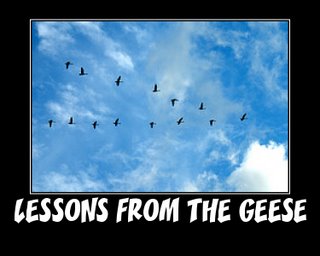Lessons from the Geese?
The geese who inhabit the wildlife preserve where we walk each day have hunkered down away from humans, preparing I think for their migration. Occasional small formations of geese fly to and from the preserve these days, but theydon’t come looking for food from us as they did in spring. I wonder if you see them, too, heading south for the winter flying along in "V" formation? Do you know what science has discovered as to why they fly that
way?
FACT 1 - As each Goose flaps its wings it creates uplift for the birds that follow. By flying in a V formation, the whole flock adds 71 per cent greater flying range than if each bird flew alone.
FACT 2 - When a Goose falls out of formation, it suddenly feels the drag and resistance of flying alone. It quickly moves back into formation to take advantage of the lifting power of the bird immediately in front of it.
FACT 3 - When the lead Goose tires, it rotates back into the formation and another Goose flies to the point position.
FACT 4 - The Geese flying in formation honk to encourage those up front to keep up their speed.
FACT 5 - When a Goose gets sick, wounded or shot down, two Geese drop out of formation and follow it down to help and protect it. They stay with it until it dies or is able to fly again. Then, they launch out with another formation or catch up with the flock.
Are there lessons we can learn from a gaggle of geese? What do you
think?
I think Oliver's comment is right on target! Teamwork is one of the best ways to achieve.
I'm adding the lessons from the geese I've found to be true; they mirror Oliver's thoughts and perhaps add some food for thought.
FACT 1- As each Goose flaps its wings it creates uplift for the birds that follow. By flying in a V formation, the whole flock adds 71 per cent greater flying range than if each bird flew alone.
LESSON - People who share a common direction and sense of community can get where they are going more quickly and easily because they are traveling on the thrust of one another.
FACT 2 - When a Goose falls out of formation, it suddenly feels the drag and resistance of flying alone. It quickly moves back into formation to take advantage of the lifting power of the bird immediately in front of it.
LESSON - If we are as smart as a Goose we stay in formation with those headed where we want to go. We are willing to accept their help and give our help to others.
FACT 3 - When the lead Goose tires, it rotates back into the formation and another Goose flies to the point position.
LESSON - It pays to take turns doing the hard tasks and sharing leadership. As with Geese, people are interdependent on each other's skills, capabilities and unique arrangements of gifts, talents or resources.
FACT 4 - The Geese flying in formation honk to encourage those up front to keep up their speed.
LESSON - We need to make sure our honking is encouraging. In groups where there is encouragement, the production is much greater. The power of encouragement (to stand by one's heart or core values and encourage the heart and core of other) is the quality of honking we seek.
FACT 5 - When a Goose gets sick, wounded or shot down, two Geese drop out of formation and follow it down to help and protect it. They stay with it until it dies or is able to fly again. Then, they launch out with another formation or catch up with the flock.
LESSON - If we have the wisdom of Geese, we will stand by each other in difficult times as well as when we are strong.
Do you see any value in these lessons?

A lesson from the gaggle of geese that we can learn, is that by working together, we can achieve a goal with high percentage. Also by working together we may be able to fix problems by helping eachother so that whatever we were doing we can continue doing it. What we learn from these geese is teamwork, and it shows that teamwork is one of the best ways to achieve something.
ReplyDelete